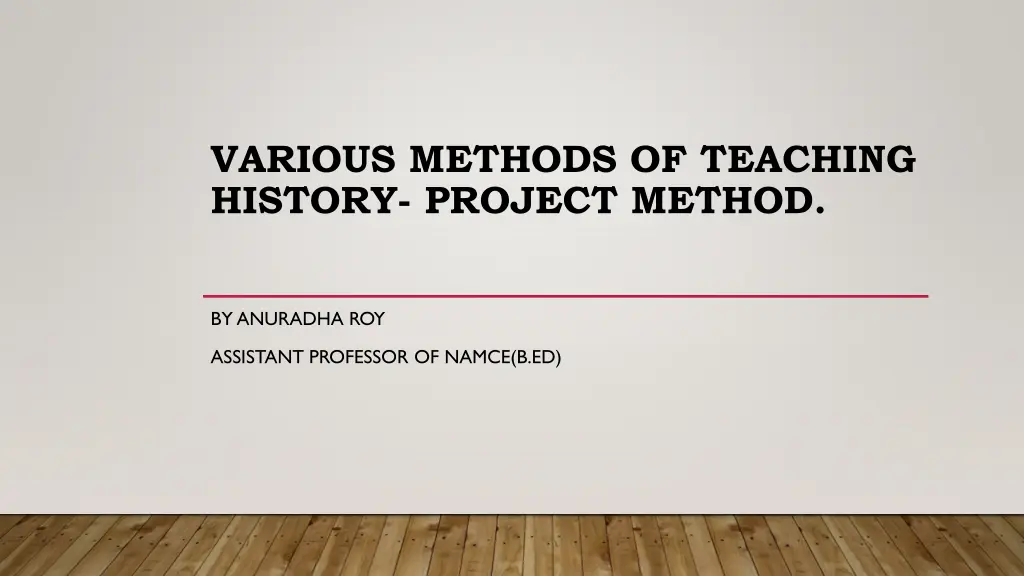
Effective Methods of Teaching History Through Project Approach
"Explore the significance and characteristics of the project method in history teaching, as advocated by renowned educators like John Dewey and Dr. William Kilpatrick. Understand the principles, steps, and essentials of project-based learning to enhance students' engagement and learning outcomes."
Download Presentation

Please find below an Image/Link to download the presentation.
The content on the website is provided AS IS for your information and personal use only. It may not be sold, licensed, or shared on other websites without obtaining consent from the author. If you encounter any issues during the download, it is possible that the publisher has removed the file from their server.
You are allowed to download the files provided on this website for personal or commercial use, subject to the condition that they are used lawfully. All files are the property of their respective owners.
The content on the website is provided AS IS for your information and personal use only. It may not be sold, licensed, or shared on other websites without obtaining consent from the author.
E N D
Presentation Transcript
VARIOUS METHODS OF TEACHING HISTORY- PROJECT METHOD. BY ANURADHA ROY ASSISTANT PROFESSOR OF NAMCE(B.ED)
SIGNIFICANCE AND MEANING OF PROJECT METHOD Project Method is a natural, whole-hearted, problem solving and purposeful activity carried to completion in a social environment. It is a practical outcome of the pragmatic environment and practical philosophy of John Dewey, a well-known American philosopher and educationist. It was developed and perfected by Dr Wiliam Kilpatrick of the University of Columbia. It is a revolt against the traditional, bookish and passive environment of the school children where in obedient masses are carefully drilled and spoon-fed with unrelated and disconnected facts.
DEFINITION Project method has been defined by various educationists as: 1. According to Ballard. A project is a bit of real life that has been imported into the school. 2. According to Burton. The problem is a project which results in doing. The motor element is not what makes the activity a project, but the problem solving of a practical nature accompanying the activity.
CHARACTERISTICS OF PROJECT METHOD i. A project is problematic act. ii. A project is purposeful activity. iii. A project is whole-hearted activity. iv. A project is activity in a natural setting. v. A project is activity in a social environment. vi. A project is bit of real life introduced in school. vii. A project is problem solving of a practical nature. viii. A project is positive and concrete achievement. ix. A project is activity through which solution of various problems are found out.
PRINCIPLES OF PROJECT METHOD i. The Principle of Purpose ii. The Principle of Activity iii.The Principle of Experience iv. The Principle of Social Experience v. The Principle of Freedom vi. The Principle of Utility
VARIOUS STEPS IN PROJECT METHOD I. Providing a situation. II. Choosing and Purposing. III.Planning IV.Executing the plan V. Judging VI.Recording
ESSENTIALS OF A GOOD PROJECT I. Timely II. Usefulness III.Interesting IV.Challenging V. Economical VI.Rich in experience VII.Co-operativeness
MERITS OF PROJECT METHOD i. Based on Laws of Learning: a. Law of Readiness, b. Law of Exercise, c. Law of Effect ii. Related with life iii. Correlates with all the subjects iv. Trains for a democratic life v. Gives training in citizenship vi. Upholds the dignity of labour vii.Stresses on problem solving attitude viii.Provides Freedom ix. Solves problem of indiscipline
DEMERITS OF PROJECT METHOD i. Neglecting intellectual work ii. Haphazard unconnected teaching iii.Difficulty of suitable textbooks iv. Lack of competent teachers v. Too much reliance on students.
CONCLUSION A review of the above brings us to the conclusion that most of the limitations are unreal and without much significance. Whenever a new method is suggested criticisms are unnecessary levelled. Traditional methods have been tried and found unsuitable to the changing needs of the time. New methods must be tried and if found suitable should be accepted.
